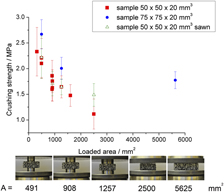Crossref Citations
This article has been cited by the following publications. This list is generated based on data provided by
Crossref.
Ji, Haipeng
Huang, Zhaohui
Wu, Xiaowen
Huang, Juntong
Chen, Kai
Fang, Minghao
and
Liu, Yan’gai
2014.
Preparation, microstructure, and compressive strength of carbon foams derived from sucrose and kaolinite.
Journal of Materials Research,
Vol. 29,
Issue. 8,
p.
1018.
Voigt, Claudia
Zienert, Tilo
Schubert, Pia
Aneziris, Christos G.
Hubálková, Jana
and
Troczynski, T.
2014.
Reticulated Porous Foam Ceramics with Different Surface Chemistries.
Journal of the American Ceramic Society,
Vol. 97,
Issue. 7,
p.
2046.
Demuth, Cornelius
Werzner, Eric
Mendes, Miguel A. A.
Krause, Hartmut
Trimis, Dimosthenis
and
Ray, Subhashis
2017.
Non‐Isothermal Simulations of Aluminum Depth Filtration.
Advanced Engineering Materials,
Vol. 19,
Issue. 9,
Hubálková, Jana
Voigt, Claudia
Schmidt, Anne
Moritz, Kirsten
and
Aneziris, Christos G.
2017.
Comparative Phenomenological Study of Fracture Behavior of Ceramic and Glass Foams under Compressive Stress Using In Situ X‐Ray Microtomography.
Advanced Engineering Materials,
Vol. 19,
Issue. 9,
Luchini, B.
Hubálková, J.
Wetzig, T.
Grabenhorst, J.
Fruhstorfer, J.
Pandolfelli, V.C.
and
Aneziris, C.G.
2018.
Carbon-bonded alumina foam filters produced by centrifugation: A route towards improved homogeneity.
Ceramics International,
Vol. 44,
Issue. 12,
p.
13832.
Kanaujia, Pawan K.
bin Ramezan, Muhammad Azkhairy
Yap, Xiu Yun
Song, Yujie
Du, Zehui
Gan, Chee Lip
Lam, Yee Cheong
and
Lai, Chang Quan
2019.
Mechanical response of lightweight hollow truss metal oxide lattices.
Materialia,
Vol. 8,
Issue. ,
p.
100439.
Storm, J.
Abendroth, M.
and
Kuna, M.
2019.
Effect of morphology, topology and anisoptropy of open cell foams on their yield surface.
Mechanics of Materials,
Vol. 137,
Issue. ,
p.
103145.
Petrenko, Iaroslav
Summers, Adam P.
Simon, Paul
Żółtowska-Aksamitowska, Sonia
Motylenko, Mykhailo
Schimpf, Christian
Rafaja, David
Roth, Friedrich
Kummer, Kurt
Brendler, Erica
Pokrovsky, Oleg S.
Galli, Roberta
Wysokowski, Marcin
Meissner, Heike
Niederschlag, Elke
Joseph, Yvonne
Molodtsov, Serguei
Ereskovsky, Alexander
Sivkov, Viktor
Nekipelov, Sergey
Petrova, Olga
Volkova, Olena
Bertau, Martin
Kraft, Michael
Rogalev, Andrei
Kopani, Martin
Jesionowski, Teofil
and
Ehrlich, Hermann
2019.
Extreme biomimetics: Preservation of molecular detail in centimeter-scale samples of biological meshes laid down by sponges.
Science Advances,
Vol. 5,
Issue. 10,
Bi, Sirui
Chen, Enze
and
Gaitanaros, Stavros
2020.
Additive manufacturing and characterization of brittle foams.
Mechanics of Materials,
Vol. 145,
Issue. ,
p.
103368.
Bergin, Are
Fritzsch, Robert
Akhtar, Shahid
Arnberg, Lars
and
Aune, Ragnhild E.
2021.
Light Metals 2021.
p.
794.
Voigt, Claudia
Hubálková, Jana
Bergin, Are
Fritzsch, Robert
Aune, Ragnhild
and
Aneziris, Christos G.
2021.
Light Metals 2021.
p.
785.
Oliveira, Fernando de Almeida Costa
Pommier, Stéphane
Fernandes, Jorge Cruz
and
Dias, Diamantino
2022.
A New Insight into the Role of Silicate-Type Binders on the Crushing Strength of Alumina Foams.
Crystals,
Vol. 12,
Issue. 10,
p.
1394.
Neumann, Marc
Hubálková, Jana
Voigt, Claudia
Grabenhorst, Joern
and
Aneziris, Christos G.
2022.
On the fracture statistics of open-porous alumina foam structures.
Journal of the European Ceramic Society,
Vol. 42,
Issue. 5,
p.
2331.
Deshpande, Vinit Vijay
and
Piat, Romana
2023.
Compression failure of porous ceramics: A computational study about the effect of volume fraction on damage evolution and failure.
Mechanics of Materials,
Vol. 177,
Issue. ,
p.
104533.
Dai, Yajie
Hubálková, Jana
Voigt, Claudia
Abendroth, Martin
Liang, Xiong
Yan, Wen
Li, Yawei
and
Aneziris, Christos G.
2023.
Tensile strength and damage of open-cell ceramic foams under cylindrical splitting test.
Journal of Advanced Ceramics,
Vol. 12,
Issue. 11,
p.
2003.
Piat, Romana
and
Deshpande, Vinit Vijay
2023.
Numerical studies of the elastic properties of ceramic foam by creation of the artificial microstructures after processing of computed tomographic images.
Vol. 2848,
Issue. ,
p.
020030.
Bergin, Are
Voigt, Claudia
Fritzsch, Robert
Akhtar, Shahid
Arnberg, Lars
Aneziris, Christos G.
and
Aune, Ragnhild E.
2023.
Investigation of mechanical and thermo-mechanical strength of ceramic foam filters (CFFs).
Ceramics International,
Vol. 49,
Issue. 5,
p.
8022.
Hubálková, Jana
and
Aneziris, Christos G.
2024.
Multifunctional Ceramic Filter Systems for Metal Melt Filtration.
Vol. 337,
Issue. ,
p.
257.
Deshpande, Vinit Vijay
and
Piat, Romana
2024.
Biaxial compression failure of brittle foams: A transfer learning-based strategy.
Procedia Structural Integrity,
Vol. 52,
Issue. ,
p.
391.
Dai, Yajie
Voigt, Claudia
Storti, Enrico
Hubálková, Jana
Gehre, Patrick
Liang, Xiong
Yan, Wen
Li, Yawei
and
Aneziris, Christos G.
2024.
Open-cell ceramic foam filters for melt filtration: Processing, characterization, improvement and application.
Journal of Materials Research and Technology,
Vol. 32,
Issue. ,
p.
3402.
